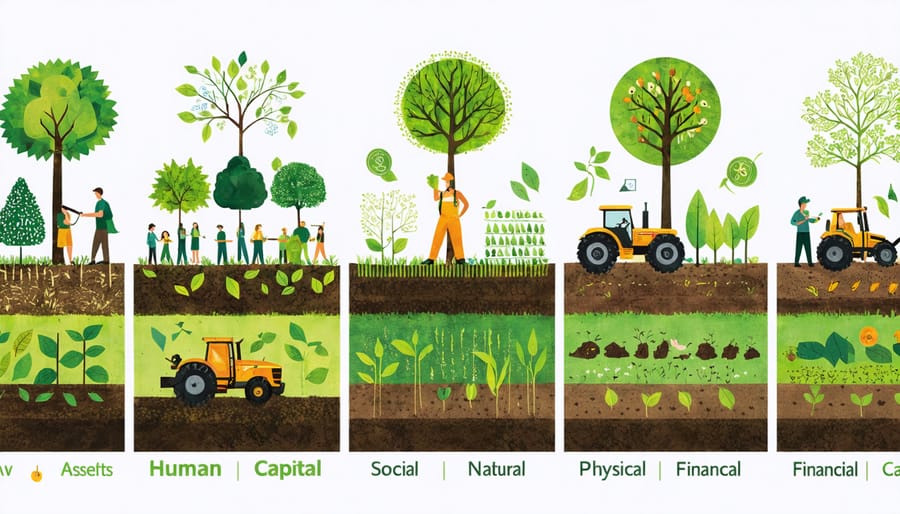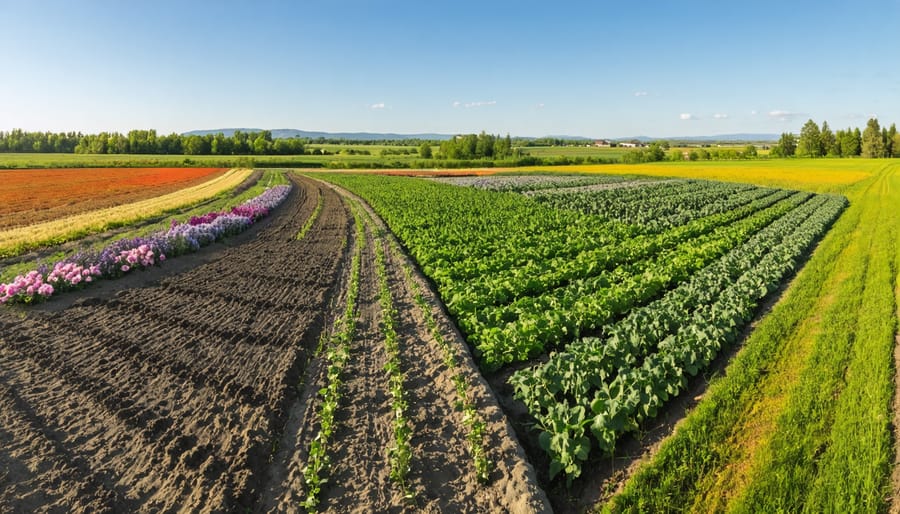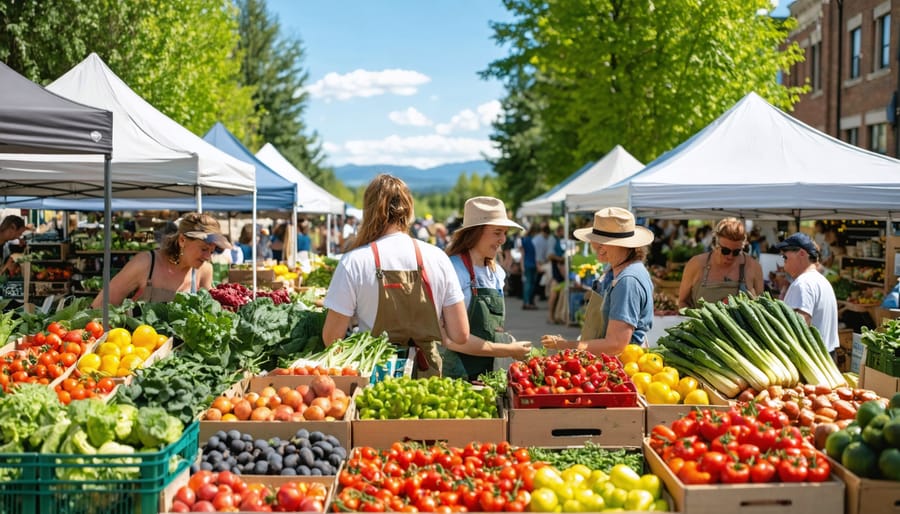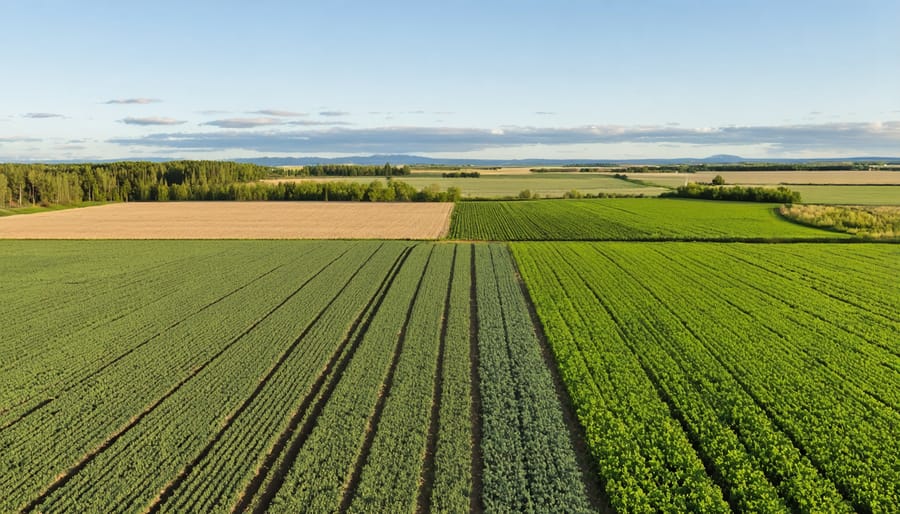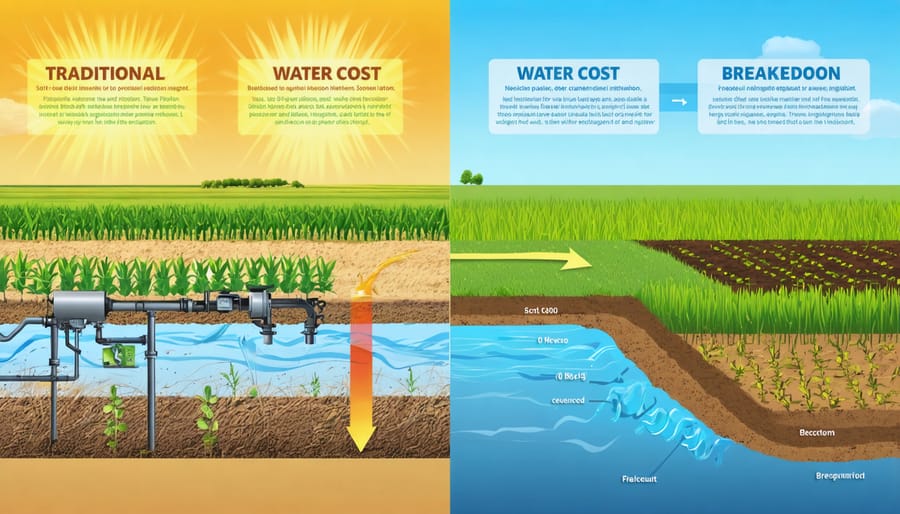In the heart of Alberta’s evolving agricultural landscape, the sustainable livelihood framework stands as a transformative approach that’s reshaping how we think about farm resilience and long-term viability. This practical framework integrates five essential capital assets – human, social, natural, physical, and financial – to create robust agricultural systems that withstand economic pressures while nurturing the environment. For Canadian farmers facing increasingly unpredictable weather patterns and market fluctuations, this framework offers more than theoretical guidance; it provides a concrete roadmap to build lasting agricultural enterprises that support both family farms and rural communities.
By examining how these different forms of capital interact and strengthen each other, farmers can make informed decisions that balance immediate needs with long-term sustainability goals. Whether it’s investing in soil health, developing community partnerships, or diversifying income streams, the sustainable livelihood framework helps agricultural professionals identify and leverage their existing resources while building new capabilities for the future. This approach has already demonstrated remarkable success across Alberta’s diverse agricultural regions, from the prairie grasslands to the parkland zones, proving its adaptability and effectiveness in the Canadian context.
As climate change and economic pressures continue to challenge traditional farming methods, understanding and implementing this framework becomes not just beneficial but essential for the future of Canadian agriculture.

Building Strong Foundations: The Five Pillars of Sustainable Livelihood Framework
Natural Capital: Your Land’s Hidden Potential
Alberta’s landscape holds tremendous potential for sustainable agriculture, with its rich natural capital serving as the foundation for long-term farm success. Understanding and nurturing your land’s inherent resources is crucial for building resilient agricultural operations.
Soil health stands as the cornerstone of natural capital in Alberta farms. Through healing the land through regenerative practices, farmers can enhance organic matter content, improve soil structure, and boost microbial activity. These improvements naturally increase water retention capacity and nutrient availability, reducing the need for external inputs while building drought resilience.
Water resources in Alberta require careful stewardship, particularly in semi-arid regions. Implementing smart water management strategies can help optimize irrigation efficiency and protect valuable water sources. Many Alberta farmers are finding success with precision irrigation systems, drought-resistant crop varieties, and water-conserving tillage practices.
Biodiversity plays a vital role in maintaining ecosystem health. Native grasslands, wetlands, and woodlots provide essential habitat for beneficial insects, birds, and other wildlife that contribute to natural pest control and pollination. Maintaining these natural areas alongside productive farmland creates a balanced ecosystem that supports both agricultural productivity and environmental sustainability.
By recognizing and investing in these natural capital elements, Alberta farmers can build more resilient operations while preserving valuable resources for future generations.
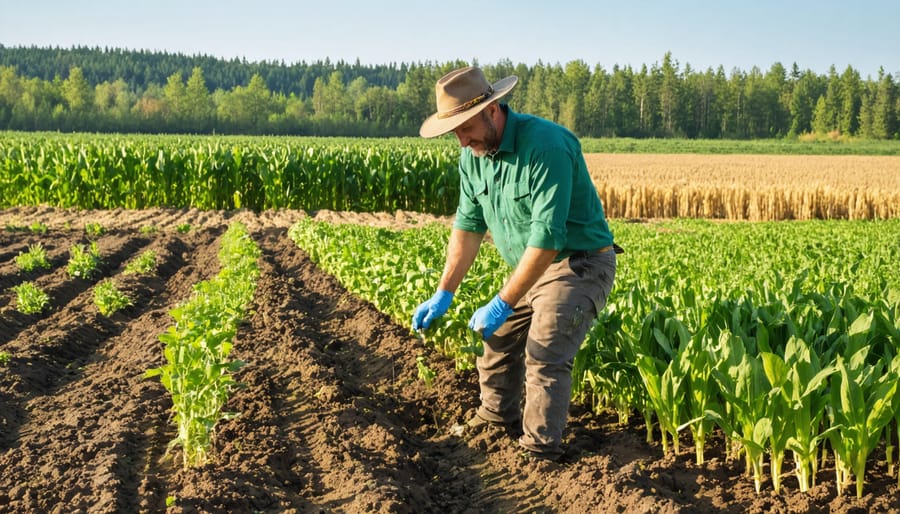
Financial Capital: Smart Investment Strategies for Agroecological Transition
Securing financial capital is crucial for successfully transitioning to agroecological practices. Alberta farmers have access to various funding streams, including government grants, sustainable agriculture incentives, and carbon credit opportunities that can help offset initial investment costs.
Smart investment strategies begin with thorough financial planning. Consider starting small with pilot projects on a portion of your land to test new practices while maintaining cash flow from conventional operations. Many Alberta farmers have found success by gradually expanding their agroecological practices over 3-5 years.
Local credit unions and Farm Credit Canada offer specialized loans for sustainable agriculture initiatives, often with competitive interest rates. Additionally, partnering with other farmers to share equipment costs and accessing group purchasing power can significantly reduce capital requirements.
Market opportunities for sustainably produced crops continue to grow, with premium prices available through organic certification, direct-to-consumer sales, and specialty market channels. Value-added processing can further increase returns on investment.
Economic benefits extend beyond direct sales. Reduced input costs, improved soil health, and enhanced resilience to climate variability create long-term financial stability. Many farmers report 15-30% reduction in operational costs within three years of implementation, particularly in areas of synthetic fertilizer and pesticide use.
Consider working with an agricultural financial advisor who understands both conventional and sustainable farming systems to develop a tailored transition strategy that protects your farm’s financial health while building for the future.
Human Capital: Skills and Knowledge for Success
In sustainable farming, success hinges on continuously developing your skills and knowledge base. Alberta’s agricultural landscape is evolving, with emerging agroforestry opportunities and innovative farming practices creating new learning demands.
Key areas for skill development include soil health management, water conservation techniques, and integrated pest management. Local agricultural extension services offer workshops and certifications tailored to our unique prairie conditions. The University of Alberta and Olds College provide specialized courses in sustainable agriculture, while mentorship programs connect experienced farmers with those transitioning to sustainable practices.
Digital literacy has become equally important, as modern sustainable farming often incorporates precision agriculture tools and data-driven decision-making. Understanding how to use soil monitoring equipment, weather tracking systems, and farm management software can significantly enhance operational efficiency.
Building your knowledge network is crucial. Joining local farming cooperatives, participating in field days, and engaging with agricultural research stations provides valuable hands-on learning experiences. The Alberta Farm Fresh Producers Association offers regular training sessions on sustainable practices specific to our climate and soil conditions.
Remember, investing in your skills isn’t just about formal education – it’s about creating a foundation for long-term farm resilience. Document your learning journey, share experiences with fellow farmers, and stay current with sustainable farming innovations through industry publications and community networks.
Social Capital: Building Community Resilience
In Alberta’s farming communities, social capital serves as a crucial foundation for building resilient agricultural systems. Local farmer networks, such as the Alberta Young Farmers and Ranchers, provide invaluable platforms for knowledge exchange and mutual support. These connections help producers share sustainable farming practices, equipment resources, and innovative solutions to common challenges.
Knowledge sharing occurs through various channels, from formal agricultural extension services to informal gatherings at community halls and local markets. Many Alberta farmers participate in mentorship programs, pairing experienced producers with newcomers to facilitate the transfer of generational wisdom while incorporating modern sustainable practices.
Digital platforms have expanded these networks beyond geographical boundaries. Online forums and social media groups enable farmers to connect with peers across the province, sharing real-time advice on weather patterns, pest management, and market opportunities. The Alberta Farm Fresh Producers Association exemplifies how organized networks can strengthen local food systems and support sustainable farming practices.
Community support systems also include partnerships with local agricultural research stations, cooperative purchasing groups, and equipment-sharing initiatives. These collaborative approaches not only reduce individual farm costs but also build stronger, more resilient farming communities. During challenging times, such as extreme weather events or market fluctuations, these social networks prove invaluable, providing both practical assistance and emotional support to help farmers maintain sustainable operations.
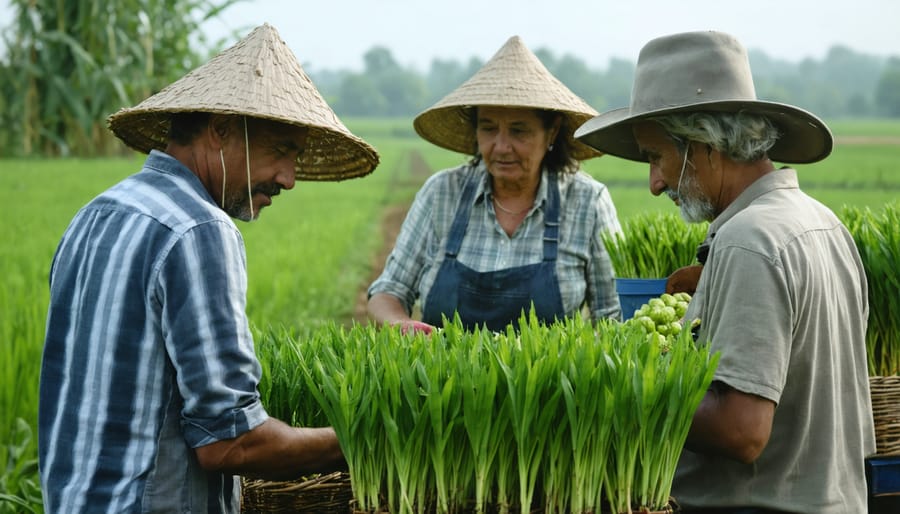
Physical Capital: Infrastructure for Sustainable Success
Physical infrastructure forms the backbone of successful agroecological farming operations in Alberta. Essential equipment includes reliable tractors, tillage implements, and irrigation systems adapted to our unique climate conditions. However, sustainable infrastructure goes beyond just machinery – it encompasses the entire farm ecosystem.
Storage facilities play a crucial role, with temperature-controlled spaces for seed preservation and crop storage being particularly important for our short growing season. Well-designed greenhouses and hoop houses can extend the growing period by up to three months, making them valuable investments for many Alberta farmers.
Water management infrastructure deserves special attention in our prairie climate. Efficient irrigation systems, water storage facilities, and drainage solutions help farmers maintain productivity during both dry spells and wet seasons. Many successful operations have implemented rainwater harvesting systems and constructed wetlands to enhance water security.
Processing facilities are another vital component. On-farm processing equipment can add value to raw products and increase farm income stability. This might include cleaning and sorting equipment, small-scale mills, or cold storage for direct-to-consumer sales.
Renewable energy infrastructure, such as solar panels and wind turbines, is becoming increasingly common on Alberta farms. These installations reduce operating costs while contributing to environmental sustainability. Many farmers have found that combining traditional farm infrastructure with innovative sustainable solutions creates resilient operations capable of weathering various challenges.
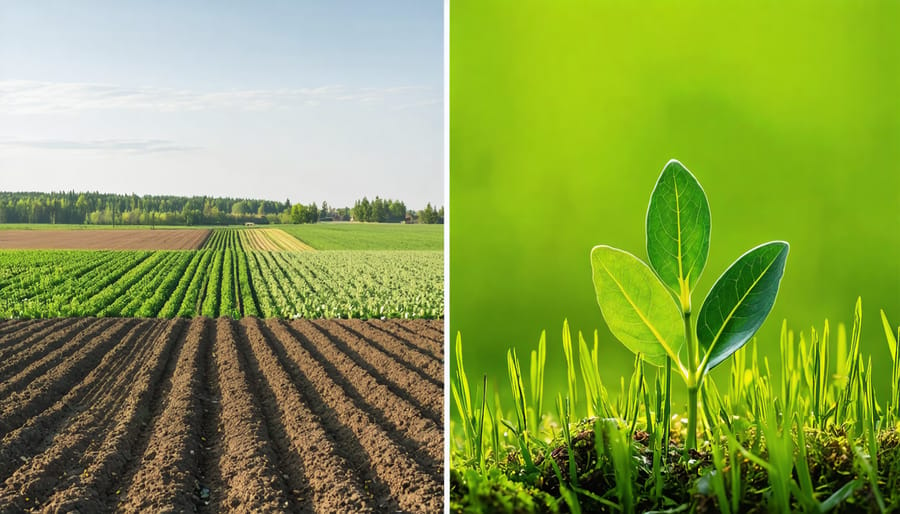
Real Success Stories: Alberta Farmers Leading the Way
Meet John and Sarah Anderson, third-generation farmers from Lacombe County, who transformed their traditional grain operation into a thriving example of circular farming systems. By implementing sustainable livelihood principles, they’ve not only increased their farm’s resilience but also improved their community’s economic stability.
“We started small, introducing cover crops and rotational grazing,” explains Sarah. “Within three years, we saw a 40% reduction in input costs and a 25% increase in soil organic matter.” The Andersons now integrate cattle, crops, and native pollinator gardens, creating a diverse ecosystem that supports year-round income streams.
In Southern Alberta, the Martinez family demonstrates how traditional Indigenous farming knowledge combines with modern sustainable practices. Their 200-hectare operation integrates drought-resistant heritage grains with innovative water conservation techniques. “Our water usage dropped by 35% while yields remained stable,” notes Miguel Martinez. Their success has inspired neighboring farms to adopt similar practices.
The Prairie Rose Collective, a women-led farming cooperative near Red Deer, showcases the social aspect of sustainable livelihoods. Starting with just five members in 2018, they’ve grown to fifteen farms sharing resources, knowledge, and marketing channels. Their community-supported agriculture program now serves over 300 families, providing stable income for members while building food security.
Technical innovation plays a crucial role in these success stories. The Petersens in Peace River use soil monitoring technology and weather stations to optimize their regenerative farming practices. “Data-driven decisions helped us reduce chemical inputs by 60% while maintaining productivity,” says Erik Petersen. Their farm now hosts regular workshops, sharing knowledge with other farmers transitioning to sustainable methods.
These Alberta pioneers demonstrate that sustainable livelihood implementation isn’t just about environmental stewardship – it’s about creating robust, adaptable farming businesses that support families and communities for generations to come. Their success stories prove that with careful planning, community support, and innovative thinking, sustainable agriculture can thrive in Alberta’s diverse growing conditions.
Success factors these farmers share include:
– Gradual implementation of changes
– Strong community connections
– Diverse income streams
– Integration of traditional and modern practices
– Continuous learning and adaptation
– Focus on long-term soil health
– Investment in appropriate technology
Practical Steps to Implement Your Sustainable Livelihood Strategy
Begin your sustainable livelihood journey with these practical, field-tested steps that have helped numerous Alberta farmers succeed. Start by conducting a thorough assessment of your current resources – list your land assets, equipment, skills, and community connections. This inventory becomes your foundation for strategic planning.
Next, identify your farm’s unique strengths and potential vulnerabilities. Consider factors like soil health, water access, and market proximity. Document seasonal patterns and climate trends specific to your region, as these will influence your strategy development.
Create a diversification plan that aligns with your resources. This might include introducing complementary crops, adding value-added products, or exploring agritourism opportunities. Many successful Alberta farmers combine traditional grain farming with specialty crops or livestock to build resilience.
Establish connections with local agricultural networks and cooperatives. Join farmer-led study groups or mentorship programs – these relationships often prove invaluable during transition periods. The Alberta Farm Fresh Producers Association and local agricultural societies are excellent starting points.
Develop a phased implementation timeline. Rather than overwhelming yourself with wholesale changes, start with manageable pilot projects. For example, convert a small plot to test new sustainable practices before scaling up.
Track your progress using simple but consistent monitoring systems. Keep detailed records of yields, soil health indicators, and financial outcomes. This data helps refine your approach and demonstrates success to potential partners or lenders.
Remember, sustainable livelihood strategies evolve with experience. Stay flexible and be prepared to adjust your approach based on results and changing conditions. Many successful Alberta farmers report that their most effective practices emerged through careful observation and gradual adaptation.
The sustainable livelihood framework offers Alberta farmers a powerful roadmap for building resilient and prosperous agricultural operations. By focusing on the five key capital assets – human, social, natural, physical, and financial – farmers can create balanced, sustainable systems that benefit both their operations and communities.
Throughout this exploration, we’ve seen how local farmers are successfully implementing these principles, from the multi-generational family farm in Lethbridge that diversified its operations to the community-supported agriculture project in Red Deer that strengthened social connections while improving soil health.
The framework isn’t just about individual success – it’s about creating lasting positive change across Alberta’s agricultural landscape. By adopting these principles, farmers can better weather market fluctuations, climate challenges, and economic uncertainties while building stronger rural communities.
Take the first step today by assessing your current assets and identifying areas for improvement. Consider joining local farmer networks, participating in sustainable agriculture workshops, or connecting with agricultural extension services. Remember, sustainable livelihood development is a journey, not a destination.
Together, we can build a more resilient agricultural sector that supports both current and future generations of Alberta farmers. Your choices today shape the future of farming in our province, contributing to a stronger, more sustainable agricultural community for all.

